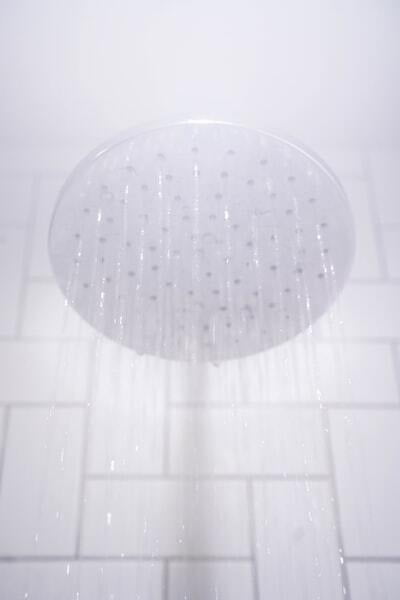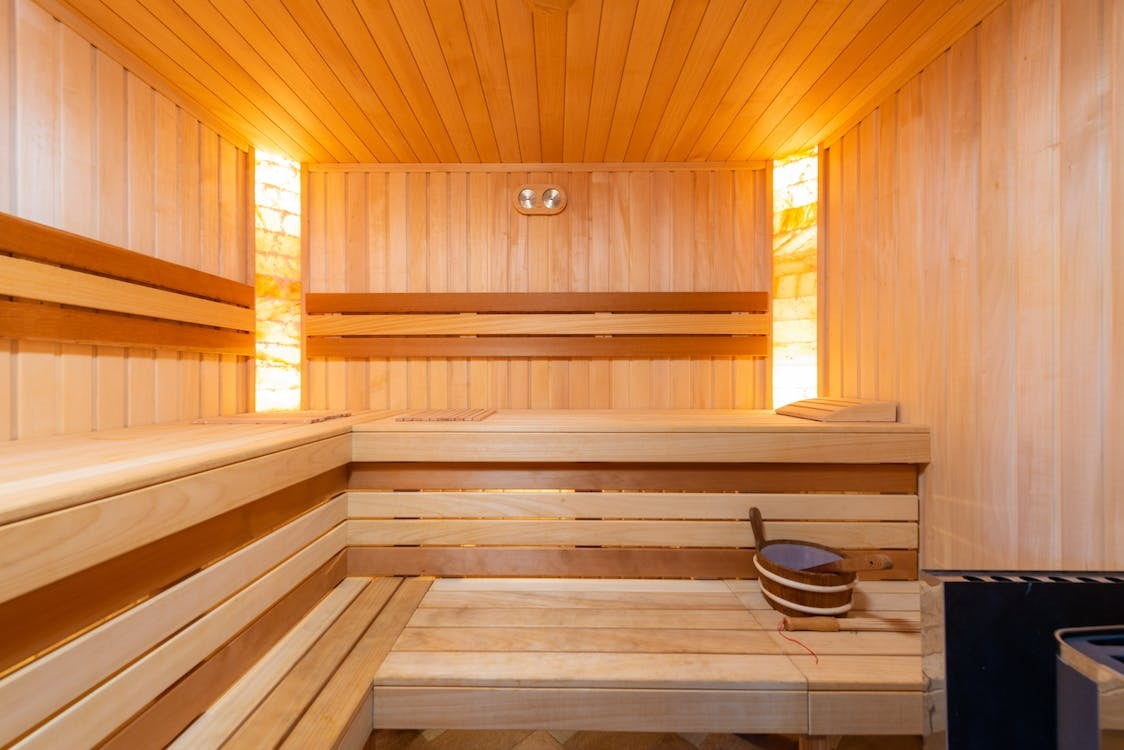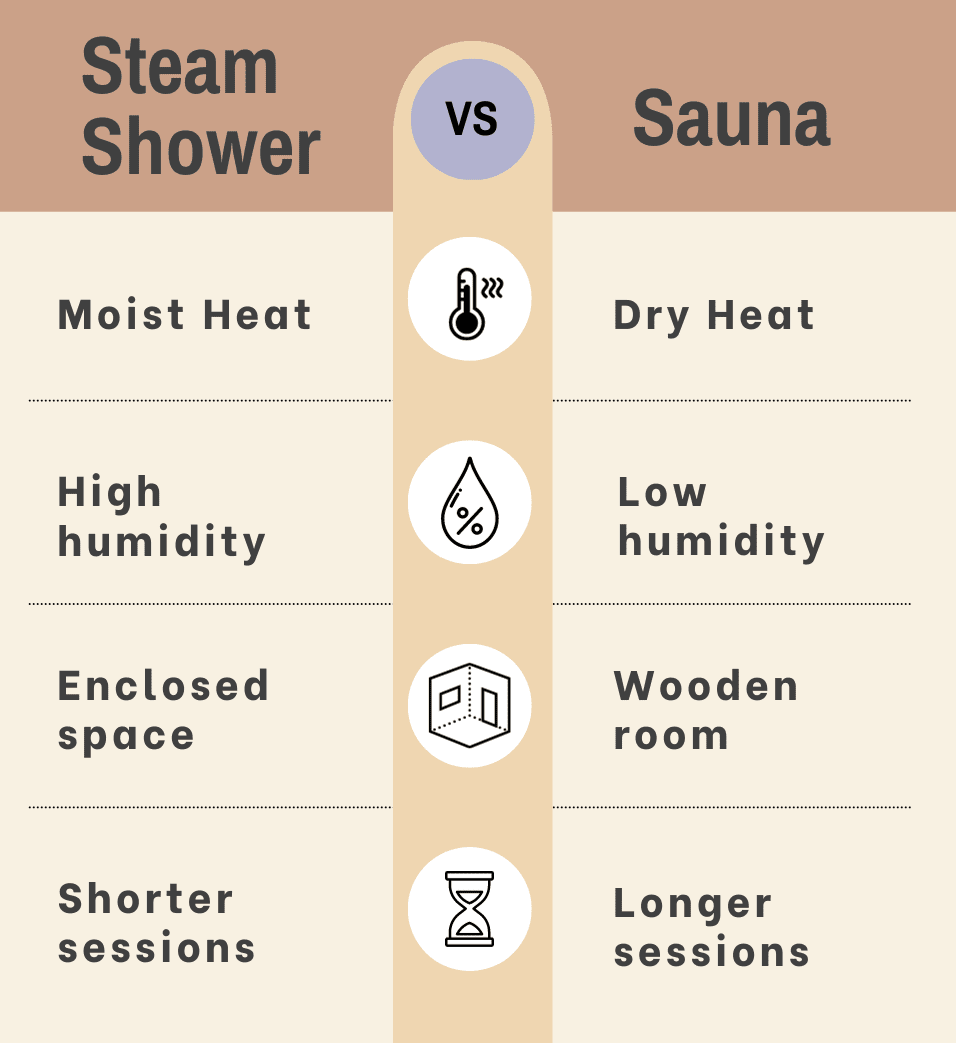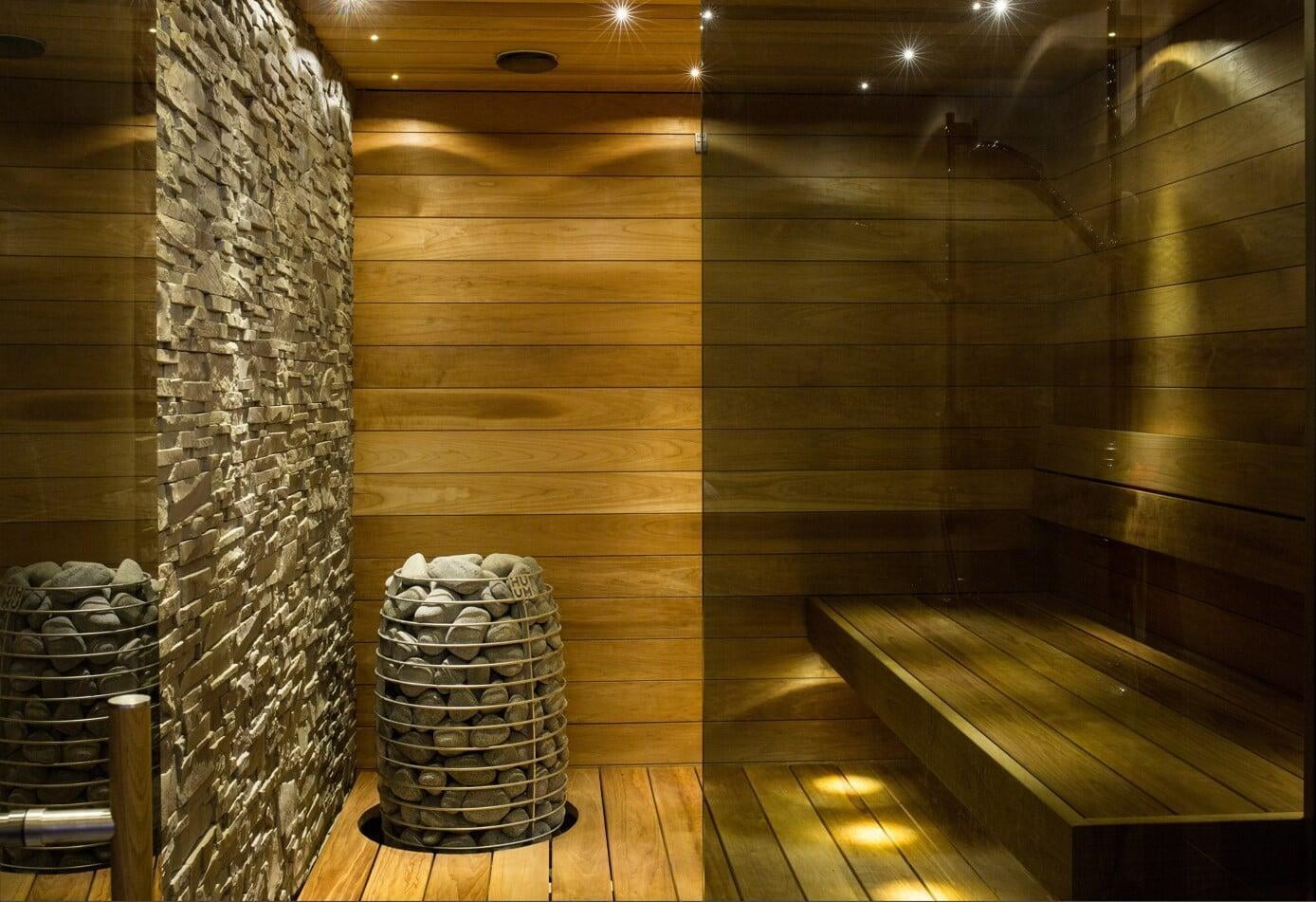Steam Shower vs Sauna: What's the Difference?
Searching for the perfect way to relax after a long day? You've likely been considering the benefits of having either a steam shower or sauna in your home. Maybe you’re wondering how these two elements compare, and that's where we come in! In this article, we'll break down everything you need to know about the differences between steam showers and saunas. So if you're considering upgrading your relaxation space, let us help shed light on which one is best suited for your needs!
A steam shower and a sauna are both designed to promote relaxation and health benefits through heat, but they provide different experiences and benefits due to their distinct features.
The main difference between a steam shower and a sauna is that a steam shower uses moist heat, producing steam and creating a wet environment, while a sauna provides dry heat, often with very low humidity.
What’s a Steam Shower?
What’s a Steam Shower?

A steam shower is a sealed enclosure equipped with a steam generator that produces water vapor. This vapor is dispersed around the user's body, offering a spa-like experience right in the comfort of one's bathroom. It's a blend of a regular shower and a steam room.
What’s A Sauna?
What’s A Sauna?

A sauna is a room used for relaxation and therapeutic purposes. It produces dry heat, usually through electric heaters or wood-burning stoves. The temperatures in a sauna are typically higher than in a steam shower. Saunas have been a part of various cultures for centuries, especially in Nordic countries.
Key Differences
Key Differences

- Heat Delivery
- Heat Delivery
- A steam shower and a sauna differ primarily in the way they deliver heat. A steam shower creates a moist heat of around 45 degrees Celsius with nearly 100% humidity, enveloping your body in warm steam.
- A sauna produces a dry heat of 70 to 100 degrees Celsius with humidity levels typically below 20%. This difference in heat type leads to distinct experiences and benefits in each setting.
- Environment and Duration
- Environment and Duration
- Steam showers are typically enclosed spaces often integrated into bathroom designs, providing a dual function of a regular shower and a steam bath. On average, sessions last between 15-30 minutes.
- Saunas are standalone wooden structures separate from other facilities. Sauna session can last longer, often ranging from 15-60 minutes.
- Construction
- Construction
- The steam shower and sauna have different construction methods due to their contrasting heat and humidity environments.
- Saunas use wood like cedar, hemlock, or pine, which can handle high temperatures and low humidity. The wooden walls and benches provide a comforting aroma when heated and absorb excess moisture, keeping the atmosphere dry.
- Steam showers are often enclosed tiled spaces with a steam generator to create high humidity. The waterproof tiles and enclosed design trap steam, creating a moist heat. These construction material differences contribute to the unique experiences offered by each facility.
Health Benefits
Health Benefits

Research has shown that regularly using a sauna or steam shower can have similar health benefits as moderate physical activity. A study published in the Journal of Human Hypertension found that sauna use was associated with lower blood pressure and reduced risk of cardiovascular disease. Another study published in Mayo Clinic Proceedings showed that regular sauna use is linked to a decreased risk of heart disease, stroke, and overall mortality. Additionally, the heat from saunas and steam showers can aid in weight loss by increasing heart rate and metabolism.
Mutual Benefits of Saunas and Steam Showers:
Mutual Benefits of Saunas and Steam Showers:
- Relaxation and Stress Relief: Promotes relaxation and stress reduction, valuable for overall well-being.
- Mental Well-being: Enhances mental well-being by relieving anxiety and depression.
- Enhanced Sleep Quality: Improves sleep quality, benefiting overall well-being.
- Detoxification: Sweating aids in detoxification, improving circulation and health.
- Weight Management: Assists with weight management by burning calories.
- Immune System Support: Supports the immune system, potentially reducing susceptibility to illness.
Steam Shower Health Benefits
Steam Shower Health Benefits
- Respiratory Relief: The steam helps clear your airways, beneficial for asthma and sinusitis sufferers.
- Skin Care: The moist heat opens up pores and cleanses your skin.
- Muscle Relaxation: The steam can help relieve muscle tension and stress.
Sauna Health Benefits
Sauna Health Benefits
- Cardiovascular Health: The high heat improves circulation and can help lower blood pressure.
- Pain Relief: The dry heat can alleviate joint pain and stiffness.
Comparing Heat Therapy
Comparing Heat Therapy
Steam showers offer a unique health and wellness experience, though they differ from traditional saunas. Traditional saunas use a drier heat, which many find more invigorating than the moist heat of steam showers. Additionally, traditional saunas tend to have higher temperatures, providing a more energizing atmosphere.
Installation and Maintenance
Installation and Maintenance
Steam showers generally tend to be more complex due to the necessity of a fully enclosed and sealed area to contain steam, as well as requiring a connection to a water line for the steam generator. This involves more extensive plumbing and electrical work. A traditional sauna, on the other hand, can be more straightforward to install.
Saunas are typically standalone units that require a simple electrical connection for the heater and do not need to be fully enclosed or connected to a water supply. However, the complexity of installation for both options can vary significantly based on the specific model and the layout of your home.
Cost Difference
Cost Difference
When considering cost, there can be significant differences between a steam shower and a traditional sauna. On average, steam showers tend to be more expensive due to their complex installation process. You should expect to pay for both the steam shower unit itself and the cost of installation, which includes plumbing and electrical work. A traditional sauna, while not inexpensive, typically has a lower overall cost because it usually requires less substantial modifications to your home. However, keep in mind that the cost can vary greatly based on the specific model you choose, the required modifications to your home, and your geographical location.
Steam Shower Vs Sauna Pros and Cons
Steam Shower Vs Sauna Pros and Cons

Steam Shower Pros
Steam Shower Pros
- Moist Heat: The humidity created in steam showers can help open up airways and moisturize the skin.
- Versatility: Steam showers can be used for both relaxation and therapeutic purposes.
Steam Shower Cons
Steam Shower Cons
- Installation Costs: Steam showers can be expensive to install and require a sealed stall to prevent moisture damage.
- Maintenance: They require regular cleaning to prevent mildew and mold growth due to the high humidity environment.
- Not Suitable for Everyone: People with certain health conditions, like heart disease or high blood pressure, should avoid steam showers as they can raise heart rate and body temperature.

Sauna Pros
Sauna Pros
- Detoxification: The dry heat encourages heavy sweating, which helps to expel toxins from the body.
- Cardiovascular Health: Regular sauna use can improve cardiovascular function and lower blood pressure.
- Stress Relief: Saunas can stimulate the release of endorphins, promoting relaxation and reducing stress.
Sauna Cons
Sauna Cons
- Dryness: The dry heat can lead to dehydration and dry out your skin if you don't hydrate properly.
- Tolerance: The high temperatures can be uncomfortable or intolerable for some people.
- Safety Concerns: Like steam showers, saunas also aren't suitable for everyone, especially those with certain health conditions.
Steam Shower vs Steam Room
Steam Shower vs Steam Room
The main difference between a steam shower and a steam room lies in their design and utility. A steam shower is often a multi-purpose fixture, combining the functions of a standard shower and a steam generator within an enclosed and sealed space. On the other hand, a steam room, also known as a steam bath, is specifically designed for steaming and typically does not include shower features. It is usually a larger room that can accommodate more people, making it a common feature in gyms, spas, and health clubs. While both provide moist heat, the steam room tends to maintain higher humidity levels compared to a steam shower.
Saunas Vs Steam Rooms
Saunas Vs Steam Rooms
Saunas and steam rooms both offer therapeutic benefits through heat, although they do so in different ways. Saunas produce dry heat, typically using hot rocks or an infrared system, while steam rooms create a humid environment.
Steam Shower vs Regular Shower
Steam Shower vs Regular Shower
The main distinction between a steam shower and a regular shower primarily lies in their functionality and design. A regular shower is typically designed for the sole purpose of bathing and rinsing the body with water, usually either cold or hot as per the user's preference.
A steam shower, however, offers a dual functionality - it not only serves as a regular shower but also includes a steam generator that produces steam for a sauna-like experience. This enclosed environment allows users to enjoy the benefits of steam therapy, such as detoxification and relaxation, within their own bathroom. Nonetheless, it's important to note that a steam shower requires a more complex installation and higher initial and maintenance costs compared to a regular shower.
Steam Shower vs Infrared Sauna
Steam Shower vs Infrared Sauna
A steam shower generates moist heat by boiling water, which fills the sealed enclosure with steam. This moist environment is excellent for detoxification and can help clear skin and respiratory systems.
An infrared sauna uses infrared heaters to emit radiant heat, which is absorbed directly by the body. This dry heat can penetrate deeper into the muscles, providing relief from joint pain and muscle aches.
Which One Is Better?
Which One Is Better?
When choosing between a sauna and a steam shower, personal preference is key. Each provides a unique experience with its own health benefits. While some may find the high humidity of a steam shower uncomfortable, others may relish the dry heat of a sauna.
Consider the installation and maintenance costs as well. A steam shower requires a more complex installation process and higher initial costs compared to a sauna. Ultimately, the decision boils down to individual preferences and practical considerations.
FAQ's
FAQ's
Are there risks with steam showers or saunas?
Yes, potential risks include dehydration, burns, and respiratory irritation. Always consult a doctor before using, especially if you have health conditions.
How often should they be used?
Start with 10-15 minute sessions and adjust based on tolerance. Stay hydrated.
Which is better for skin: sauna or steam room?
Steam rooms are more hydrating, ideal for dry skin. However, some may find them stifling.
How long should you stay in a steam shower?
Typically, 20 minutes is sufficient. Adjust based on personal comfort.
Is it better to use a steam room or sauna post-workout?
Both can be beneficial post-exercise, depending on personal preferences.
Steam shower vs infrared sauna: which is better?
Infrared saunas penetrate deeper into the body, offering therapeutic benefits. They are also more cost-effective.
Which aids in weight loss: sauna or steam room?
Both can assist in temporary weight loss due to sweating, but neither should be relied upon for long-term weight loss.
Conclusion
Conclusion
Both steam showers and saunas offer unique benefits and can be great additions to any home spa or wellness routine. Whether you prefer the moist heat of a steam shower or the penetrating dry heat of a sauna, both can provide numerous health benefits and help promote relaxation and detoxification.
Consider your personal preferences, budget, and installation requirements when deciding between the two options. With proper maintenance and usage, both steam rooms and saunas can be valuable tools for promoting overall health and wellness.
Incorporating either a steam shower or sauna into your routine can help enhance your self-care practices and leave you feeling rejuvenated and refreshed. So, if you haven't experienced the benefits of a steam shower or sauna yet, now is the time to try it out for yourself! Happy relaxing!
So next time you're feeling stressed, sore, or just need a little self-care, consider taking some time to unwind in a steam shower or sauna. By understanding the differences between these two options and how they

